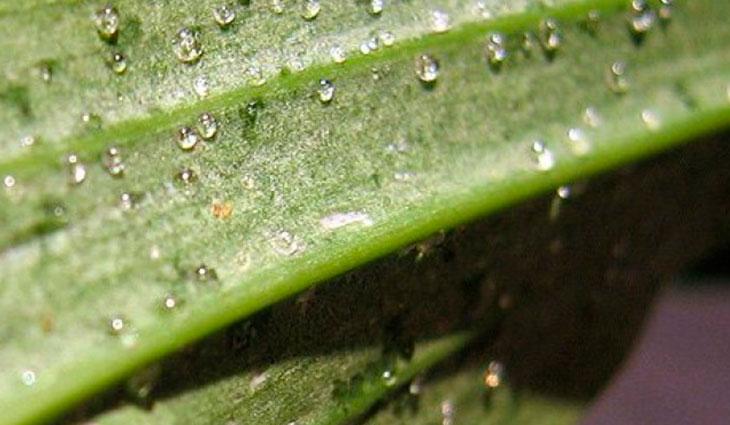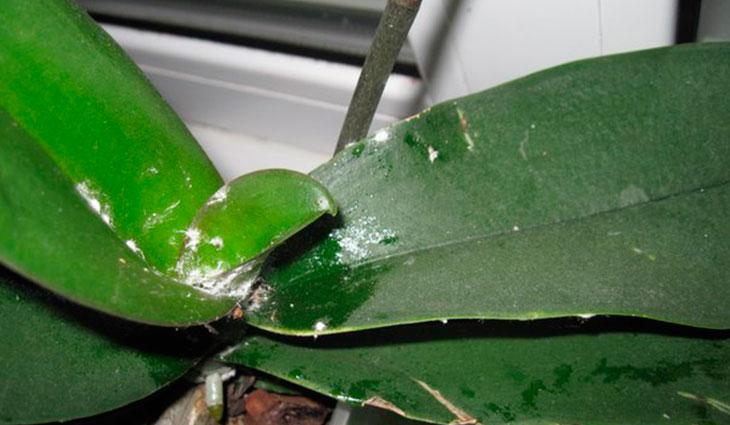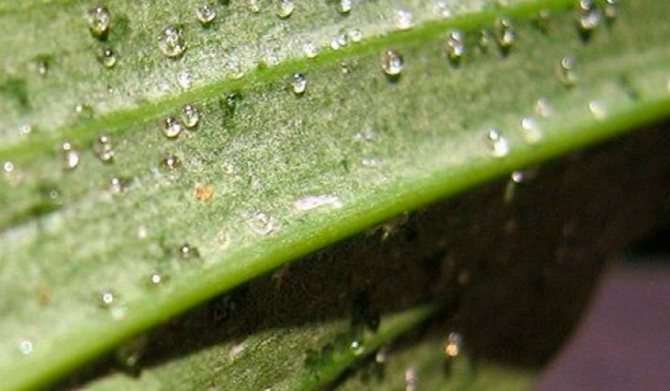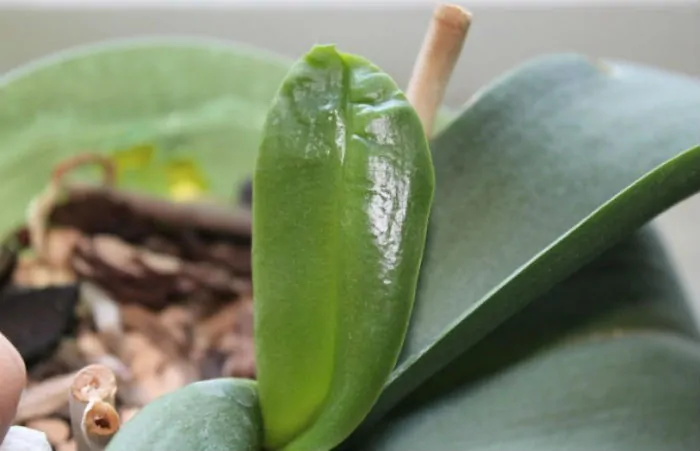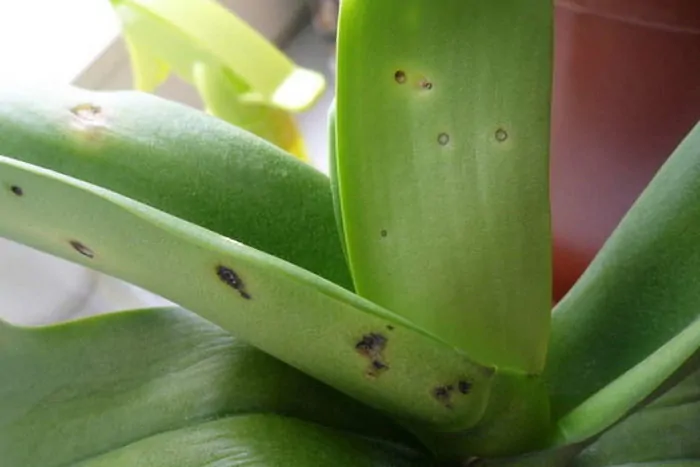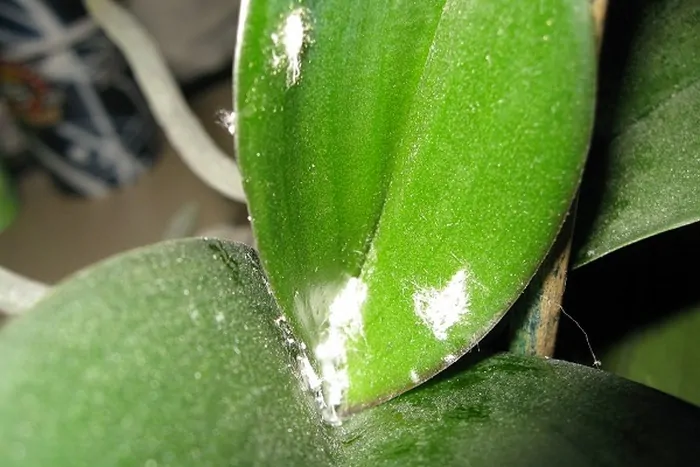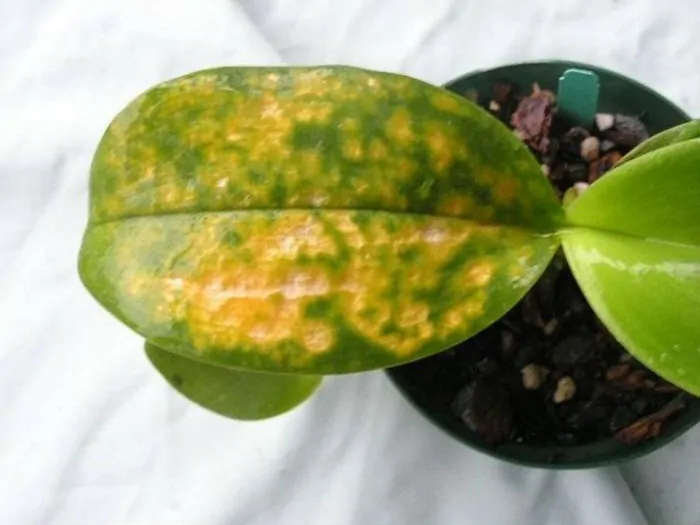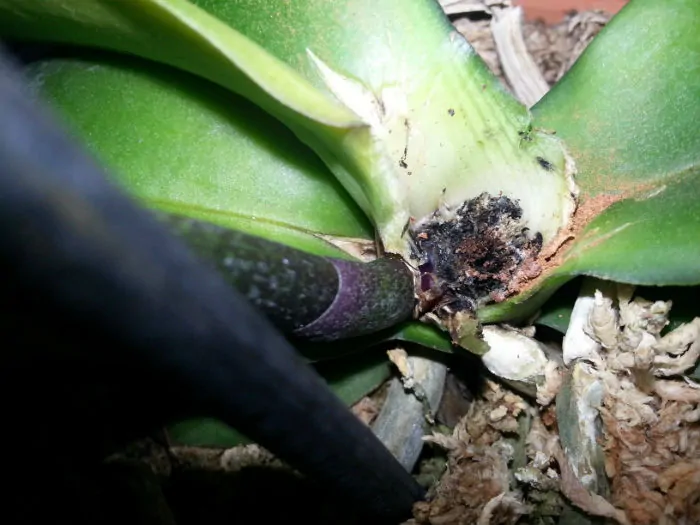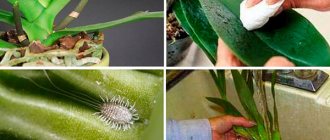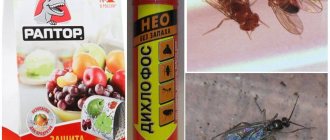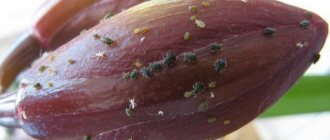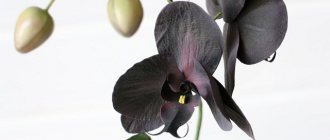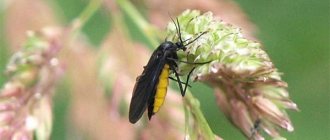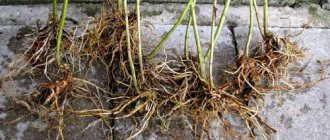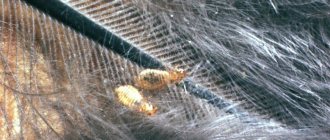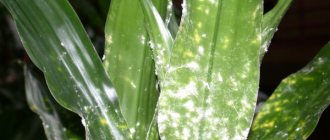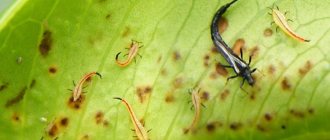Orchid is a wonderful plant, but at the same time capricious and expensive. That is why the happy owners of phalaenopsis and other species are so shaking over their brainchild. They create all the necessary conditions for keeping, constantly monitor the state of the plant, periodically plant overgrown bushes, and all this only so that their orchid feels good and does not need anything.
But there are such troubles, from which you cannot protect yourself with the correct temperature or watering regime. It's about the attack of pests and the development of infections in orchids. Otherwise, these troubles are called white bloom.
Why does it appear on the leaves?
Due to unsuitable conditions of detention, metabolism is disturbed, this leads to a change in the composition of the vegetable juice. As a result, the orchid becomes an excellent target for parasite attacks and the rapid progression of fungal infections. We single out a group of main reasons:
- Frequent feeding with nitrogen fertilizers.
- Dryness or excessive humidity in the room.
- Frequent watering - water stagnates in the ground.
- Contaminated soil. The problem arises if you dig up the soil for the orchid in the garden, garden.
- Fallen withered leaves, withered flowers in a pot. They start to rot and are a "house" for parasites.
Root rot
Keep in mind that the roots can be affected by both rot and fungus. Often they are affected by such types of rot as:
- Gray. It affects both roots and leaves. You can determine the presence of a problem by the dark areas with a bloom of gray in different places of the plant. Often the problem is with the leaves. After them, the soil, the roots, and the flowers suffer. The cause of rot is high humidity and low room temperature. Excessive use of fertilizers with an increased concentration of nitrogen can also affect the appearance of gray rot. Keep in mind that gray mold is a fungus. If spots are found, remove by cutting out all affected areas, and spray healthy areas with fungicides. When reappearing, you cannot use the same drug, you need to select another one. The appearance of gray rot is typical for cattleya, phalaenopsis, cymbidium and other varieties of orchids with white flowers. For prevention, when watering, you need to use drugs to increase the resistance of orchids to diseases, in addition, do not put the orchids close to each other.
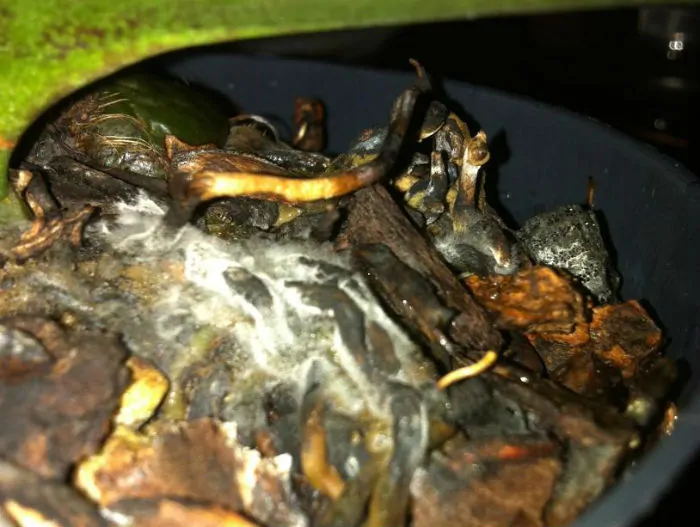
- Root. It appears on the roots of the plant. They become soft and die off over time. Brown leaves are another indication of the presence of the disease. Root rot is caused by high temperature and humidity in the room. If you have already seen the problem, spray the roots with a solution of foundationol (0.2%) or topsin (0.2%). Repeat the procedure three times every 20 days. The disease often includes cymbidium, miltonia, and pafiopedilum. Prevention can be the use of a quality substrate.


All of these orchid root system problems are considered the most common. Moreover, in most cases it is possible to cope with them. The main thing is to notice the problem in time and quickly start treatment.
What does its presence lead to?
Plaque on the leaves always indicates a problem. The consequences of its appearance are also usually negative.In an orchid, green parts can dry out, flowering stops. In an infected flowering plant, the buds wither, the inflorescences dry and fall off. In extreme cases, but only if the painful state of the orchid is ignored and in the absence of therapeutic measures, the plant dies.
When infected with a mealybug, the female insect inflicts indelible harm. She sticks to the leaf of the plant, drinks the juice and at the same time injects a poisonous poison. The parasite also leaves sticky marks, which are an excellent medium for the spread of the sooty fungus. A pest nest can be detected by a clot of white airborne coating. Both adults and larvae (small white dots) live in it.
Are sticky drops harmful
The sticky drops on phalaenopsis leaves are called extra-flower nectar. They are not always signs of illness. Sometimes this is a natural process that does not affect the life of the plant.
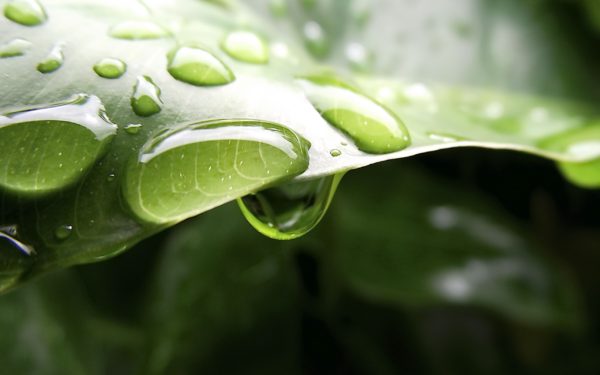

Drops do not always indicate disease.
By itself, extra-flower nectar does not harm the flower. But it can be a sign of improper care. Most often, the appearance of drops is an alarming sign, after which you need to carefully consider the phalaenopsis and find the cause of the anomaly. This is fraught with the manifestation of diseases or pests.
Step by step instructions on how to deal with home remedies and chemicals
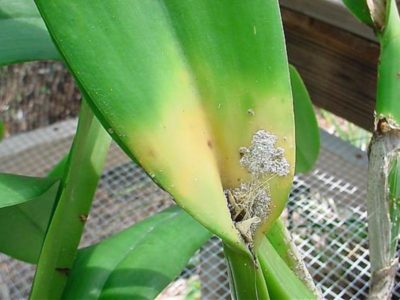

Let's figure out how to get rid of the white bloom that affects the plant on home orchids. Flower treatment depends on the exact cause of the plaque on the leaves or other parts of the plant. When infected with powdery mildew or mealybug, various therapeutic measures are required.
But mandatory general actions:
- isolating the infected orchid from other plants;
- removal of all damaged parts (leaves, buds), cover the cuts with crushed activated carbon;
- only after the removal of the infected leaves can the treatment begin.
How to treat powdery mildew infection?
It is necessary to remove the top soil layer and pour new soil into the pot. It is advisable to take a special soil substrate, and not ordinary land from the garden. Sprinkle the new soil from above with ash (thickness up to 2 cm). What are the next steps to take?
- For mild damage, safe homemade decoctions can be prepared. You can take horsetail herb (100 g per 1 liter of water), garlic (50 g of chopped slices per 2 liters of water), onion husks (200 g per 10 liters of water). Be sure to boil and insist. Dilute with water before processing. Spray through a spray bottle.
- In case of mass destruction, chemical treatment is indicated. These are copper-containing fungicides or antifungal agents. Colloidal sulfur or Fitosporin is suitable. Look for the dosage on the package.
- Disinfection of the place where the pot stood with an antiseptic. The goal is to kill the remaining spores.
What to do if a mealybug appears?
If you see that there are too many insects, the help of chemicals is required.
- We need to take insecticides. These are Aktara, Aktellik, Mospilan, Fitoverm. Observe the dosage for home flowers. Treat with protective gloves.
- Next, place the orchid in a bag, spray the plant and tie the bag for 2-2.5 hours.
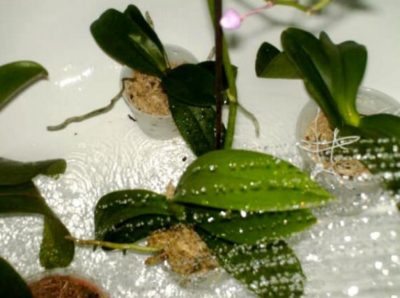

After the expiration date, remove the orchid and wash with soapy water.- Repeat the treatment 3-4 times, the time interval between procedures is 10-14 days.
Obligatory additional actions - disinfection of the soil in the pot and the place where the pot stood with an antiseptic. Also you need to carefully examine the neighbors of the infected orchid, or better, send all neighboring flowers to quarantine for 14 days.
From the video you will learn how to treat an orchid for a mealybug:
Ways to combat fungal disease
To eliminate powdery mildew, it is recommended to use fungicides "Topaz", "Fitosporin", "Skor". Treatment should be carried out by spraying plants from a distance of 20-30 cm.1 hour after the procedure, it is necessary to wipe the leaf sinuses with a cotton swab if moisture stays in them.
Treatment must be carried out 2-3 times at intervals of 5-7 days, depending on the drug, until the signs of the fungus disappear completely.
Florists who do not accept chemicals are advised to use folk remedies to eliminate the disease:
- Garlic. Grind 5 cloves of the vegetable component and pour 500 ml of warm water. Insist the mixture for 5 hours in a closed container. Subsequently clean and use for spraying.
- Field horsetail. 100 g pour 500 ml of boiling water. After 2 hours, clean and use on the affected plant.
It should be understood that folk remedies are effective only at the beginning of the development of the disease, as they have a gentle effect. When the situation is critical, it is better to use fungicides.
Prophylaxis
General ”prevention rules are well known, but not all growers adhere to them. Remember that the health of a home orchid depends on the quality of compliance with preventive measures.
- Adequate lighting. Phytolamps can be used as an additional light source.
- Purity... Remove fallen and dried leaves from the soil in time.
- Optimum humidity. It should not be too high, but it should not be dry in the room either.
- Watering. You do not need to water and spray the plant abundantly. It is better to blot the drops remaining on the green parts with a napkin.
- Leaves care. Once every 3-4 weeks, wipe the orchid leaves with soapy water or take a warm shower.
- Top dressing. Do not use nitrogen fertilizers too often and abundantly. Better to replace them with fluoride and potassium.
What does white bloom look like on an orchid?
A white sticky coating can affect a flower in two cases: the plant has caught an infection or it has been attacked by pests. Both the first and the second are extremely dangerous for the orchid: it can quickly kill it. Treating such ailments is also quite difficult.
If the plant catches an infection, then the symptoms are somewhat different. Usually, with fungal infections, the lower surfaces of the leaf plates are primarily affected. They are covered with a powdery coating, which grows as fungal spores develop. The danger is that the fungus grows very quickly, which means that the lack of timely treatment will lead to decay of the orchid.
White bloom can appear on the following areas of the plant:
- on sheet plates;
- stems;
- root system.
On the leaves
Often, diseases and infections affect orchid leaves. Over time (and in the absence of proper treatment), the problem can spread to the stems, but rarely the problems begin with them.
Usually at risk are those flowers that do not receive proper care. Their immune system weakens and opens the way for all possible infections, among which white plaque is the most common. Lack of proper care leads to a malfunction of metabolic processes in the orchid, and this, in turn, affects the composition of the plant sap. It is because of this that various diseases and pests perceive orchids as easy prey.
Depending on the cause of the lesion, the disease may look differently. Most often, the main signs of a problem are:
- drying of the leaves and stems of the orchid;
- premature end of flowering (poor flowering);
- inflorescences fade quickly, fall without even opening;
- sticky drops appear on the leaves;
- over time, the sticky drops turn into a white coating.
On stems
White bloom rarely occurs on orchid stems. Most often, he goes there at the later stages of the development of the disease from the leaf plates. It usually looks like this:
- sticky drops of sweet secretion;
- white powdery dusting with the texture of cotton fibers;
- gray-green mold.
On the roots
In most cases, the roots of an orchid undergo an infectious attack. This part of the plant is difficult for pests to access, so they prefer something simpler, such as leaves.
The main problem that orchid owners may face is mold. This fungal infection looks like a fibrous plaque that can appear on all parts of the plant (except for the inflorescences). Mold multiplies with the help of spores, so the disease spreads quickly, affecting all healthy areas in a short time. If a fungus has been brought into the house, expect a complete infestation of the plants.
The color of the mold may vary:
- light gray (just this variety is called white);
- green;
- black.
Outwardly, it looks like a shaggy crust that covers the roots of the plant. This disease is also dangerous because it can stay dormant for a long time somewhere in the roots of an orchid. As soon as the external environment allows, the fungus immediately wakes up and begins its vigorous activity.
Root diseases and flowering problems
Diseases of the roots cause problems with flowering, but we will talk about diseases of the root system later, but weak flowering is a problem that often occurs. The main reasons for the lack of buds are as follows:
- improper watering;
- sudden changes in temperature;
- violation of the rest regime;
- insufficient lighting.
Another problem is that buyers forget to check with the seller what kind of plant they purchased and how exactly it blooms, as well as generally find out the description of the plant. It is important to understand that different types of orchids produce buds and bloom at different times of the year. It often happens that the owner is looking forward to the first flowers, but only the green mass is growing.
Note! Lack of light is the most common cause of plant wilting. Most varieties of orchids do not tolerate even partial shade well. They need good lighting, so the plant should be placed on the windowsills, and not in the corner of the room. The exceptions are varieties such as Phalaenopsis and Pafiopedilum, which can bloom in partial shade.
How to understand that an orchid lacks light? It's not hard. Pay attention to the color of the leaves. The natural shade is soft green, light and even slightly muted. Bright green tones are a sign of a lack of lighting. If the leaves turn yellow, then this is a signal that an excessive amount of ultraviolet radiation is getting on the plant.
What to do in a similar situation? Place the plant either in a more illuminated place (in the case of bright green leaves - a vivid example in the photo), or in partial shade (if you notice yellowness).


An equally common reason for the lack of peduncles in orchids is root diseases. It is very difficult to identify this problem, especially if the plant is already in bloom. The latter can be observed even in the case of root rot. But if the plant does not please with either flowering or buds for a long time, it's time to check the root system. Rot (most common) is caused by over-watering. Remember to bathe the plant by placing it in a bowl of water for 20-40 minutes once a week. This flower is enough. But you do not need to fill it with water so that it stands in the pot.
What to do in a similar situation? The best solution is to transplant the flower into a new pot and remove the damaged areas of the roots. In principle, transplanting is useful as a periodic occurrence in plant care.
Why might it appear?
There are many reasons for the appearance of a harmful white coating on an orchid. Most often, the plant gets sick:
- with improper care;
- non-compliance with the temperature regime;
- improper watering.
It is also worth noting that the development of the disease may be a consequence of the contamination of the substrate.So thorough disinfection of all tools and soil is a prerequisite for the normal growth of the plant.
Improper care
Many factors can be attributed to them. Most often, the plant suffers in the winter., since at this time the amount of natural light decreases, the air becomes drier, water stagnates in the ground.
Decay of the root system and the formation of fungal deposits on roots, leaves or stems are common consequences of improper care. All this happens due to waterlogging of the soil.
As a result, the orchid:
- dies;
- attracts pests;
- rots, infecting the substrate.
Careful adherence to the irrigation regime should also be associated with strict adherence to the temperature regime, since mealybugs, which are dangerous for orchids, feel quite comfortable in a dry and warm place, but at the same time they are afraid of moisture. To keep the roots healthy, while protecting the leaves and stems from pests, wipe the leaf blades with a damp cloth, and spray instead of watering.
The temperature regime in summer should be kept within + 18 ... + 30 degrees, in winter + 20 ... + 23 degrees is enough. Air humidity must be at least 55%.
The timely removal of dried parts of the plant is also important. This helps protect the orchid from the spread of pests. Standard pruning is an excellent preventative measure.
Infection in the ground
Sometimes contaminated soil can be the cause of orchid disease. That is why most gardeners are advised to purchase ready-made soil mixtures only in trusted stores.
If you prefer to prepare the substrate yourself, be sure to disinfect:
- Take a pre-prepared bark for the substrate.
- Dry the bark in the oven at +60 degrees for 15-20 minutes to kill all possible pests and bacteria.
- Disinfect the plant seedlings before planting them in sterile soil.
Bacterial leaf spot
Phalaenopsis orchid diseases can also manifest themselves in the form of various leaf lesions. For example, if the irrigation regime is not followed and the air temperature is high, bacterial spotting begins to spread on the plants.
At first, the affected leaf blades begin to turn yellow, then they darken, become soft, and cracks begin to appear on their surface. The most characteristic sign of bacterial leaf spot is wet black spots on the surface of the leaf plates.
Treatment
To treat an infected plant, all spots on the leaves of the phalaenopsis orchid are cut out with a pre-disinfected sharp instrument. After that, the wound surface is treated with charcoal powder or an alcohol solution of iodine.
In cases where dark spots have occupied almost the entire surface of the leaf or the damage has already affected the central vein, undiluted Fitolavin is used for treatment. It has the ability to persist in tissues for a long time. If there are no signs of disease within 2 weeks after the treatments, the plant is considered to have fully recovered.
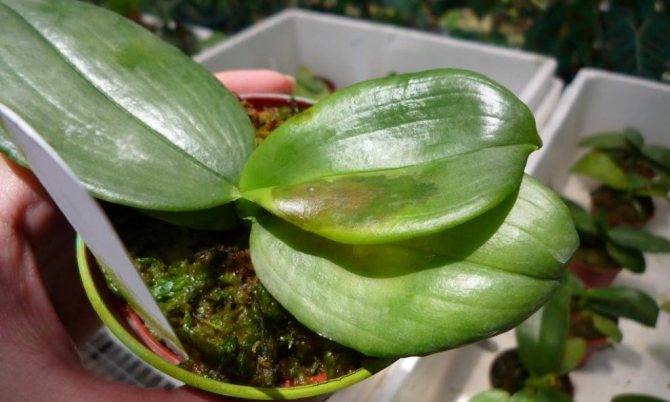

Bacterial spots on orchid leaves
What is the danger of sticky plaque?
Regardless of what caused the infection of the orchid, the lack of proper treatment can lead to its death. Fungal infection will cause rotting of the root system and the death of the flower.
When a mealybug is affected, females of an insect pose a particular danger, since it is they who, with the help of their oral apparatus, gnaw holes in the orchid, stick to it and suck life-giving sap. In the depressions of the leaves, these parasites prefer to arrange their clutches, which outwardly look like small lumps of cotton wool.
From a flower, pests quite calmly move to pots, windowsills and windows.There they hang everything with their spider web. It closes the stomata of plants, preventing them from breathing, and outwardly it looks, to put it mildly, unaesthetic.
The female scale insects are overly fertile. They are capable of laying eggs four times a year. The larvae hatch from the clutch after 10 days. Young animals are very nimble: individuals quickly orient themselves on the terrain, find a place for feeding and begin to develop. From feeding, they grow rapidly, filling more and more territories with their colonies. If untreated, such rapid reproduction will destroy the plant.
The appearance of worms can be associated with the following reasons:
- the plant was weakened earlier by the attacks of other parasites;
- the orchid received the wrong care;
- the soil was initially infected or has not changed for a long time and therefore depleted.
How is the disease treated?
If you notice signs of infection in an orchid, disinfect the plant immediately:
- Remove all peduncles (regardless of whether there are lesions on them or not).
- Dissolve 15 ml of liquid soap in a liter of clean water, mix well.
- Using a cotton swab, wipe the plant with a soapy composition, carefully removing all insects visible on the leaves and stems.
After this procedure, quarantine the plant for a few days. Watch him. If its condition has not worsened, return the orchid to its original place and pay more attention to caring for it.
Chemical and biological agents
Pest control is in many cases more difficult than fungus control. The mealybug clings to its territory and will not leave it so easily.
The most effective drugs that can kill the parasite are:
All of the above insecticides fight both adults and larvae. After treating the plant with the drug, close it with a plastic bag and leave it for 25–35 minutes. This will help enhance the effect of the remedy. Do not administer the treatment in a room that someone else lives in.: take diseased plants outside or at least on a non-residential balcony.
Observe precautions when working with chemicals: protect all exposed areas of the body, face, eyes from accidental ingestion of the composition, do not drink, smoke or eat while processing plants.
Treatment with folk methods
Folk recipes will help to cope with pests only at the initial stages of the development of the disease. Do not expect magical results from them if the parasite has already captured more than 50% of the flower.
The most effective remedies:
- Garlic infusion... Take 5 garlic cloves, pour 1 liter of boiling water and leave for a day. Strain the finished mixture and treat the affected areas of the flower with it.
- Onion infusion... Peel and chop one medium onion. Pour the raw material with warm purified water, leave the mixture to infuse for 2-3 hours. Strain the broth and sprinkle it on the orchid.
- Pepper infusion... Take 50 g of hot pepper, pour 500 ml of boiling water over it, then put it on the stove and boil for 5 minutes. Cool the finished mixture, strain. Treat the diseased plant with a decoction.
What to do with white dots?
The only possible method for getting rid of white indented spots or white dots on an orchid is through careful grooming:
- normal watering regime;
- timely treatment of pathologies.
If you monitor the condition of your orchid, then the consequences of the illness will soon disappear.
How to get rid of a pest?
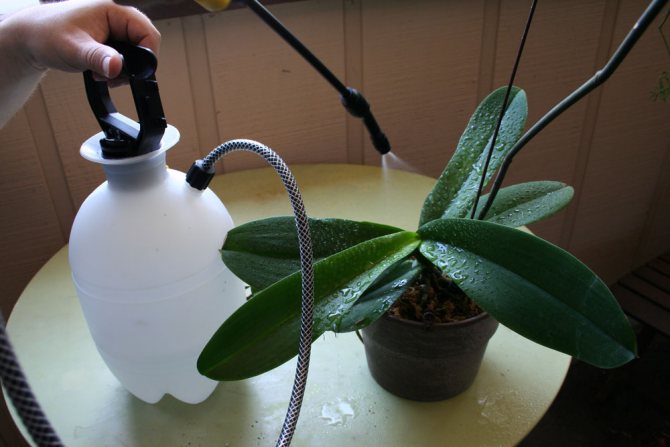

If a white sticky bloom has appeared on orchids, then it is necessary to fight it with the help of insecticides. Moreover, one should not only spray the leaves, but also water the plant with a working solution. The treatment must be repeated every week until the mealybug is completely eliminated.
- "Aktellik", "Fitoverm". Dilute any of these insecticides at the rate of 2 ml per 1 liter of water. Mix thoroughly and spray on the leaves.In case of mass accumulation of the pest, it is necessary to additionally moisten a cotton pad in the working solution and wipe the especially affected areas.
- Aktara. Dissolve 1.4 g of the drug in 6 l of water. Apply the resulting product for watering orchids. This will allow the poison to penetrate the roots, and then into the leaves and stem. This will lead to the death of pests when the cell sap is sucked out.
An alternative to chemicals can be folk remedies for pests, but they are recommended to be used only at the first signs of damage. During the period of mass reproduction of the mealybug, they will be useless.
- Add olive oil (50 ml) to 1 liter of water at a temperature of 40 degrees. stir the product. Use to wipe the front side of leaves in places of mass accumulation of worms.
- Mix 10 ml of rubbing alcohol, 15 ml of dishwashing liquid and 1 liter of water. Use the mixture to spray the affected plants. It is unacceptable to use the product for narrow-leaved orchids.
Preventive measures so that the flower does not become covered with white fluff
In order to avoid such problems with the orchid, some preventive measures should be followed:
- Water the orchid only when the soil is completely dry.
- Periodically arrange a warm shower for flowers to remove excess moisture from the sheet plates.
- If the temperature drops, reduce the number of waterings.
- When shortening daylight hours, use phytolamps.
- Observe the temperature regime.
- Perform a preventive treatment every three months.
- Transplant orchids only into proven soil.
White sticky coating on leaves and stem
If a cobweb-like white sticky coating has formed on the leaves or stem, this is a sure sign of the presence of a mealybug... Under it, the pest lays its eggs. An adult female of white, beige or pink color reaches a length of no more than 5 mm, and the bristles along the body are strewn with a white powdery coating.
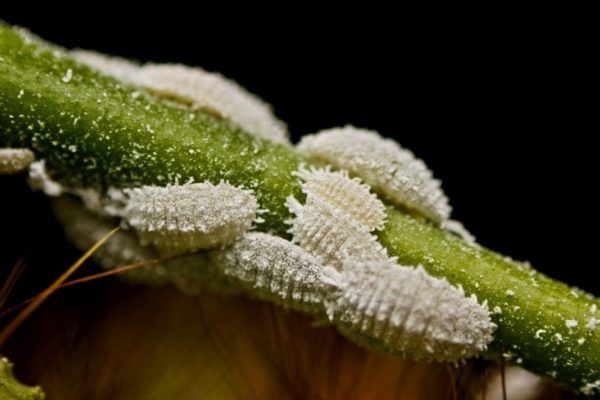

A white bloom on an orchid indicates the appearance of a mealybug.
Orchid defeat by mealybug occurs in several stages:
- The appearance of sticky drops on the leaf blade;
- Formation of a white, sticky coating, similar to cotton wool;
- Changing the shape of leaves and buds, the leaf blade acquires a marbled color with yellow or red spots.
In the later stages of the disease in the leaves the process of photosynthesis is disrupted, which leads to the death of the orchid.
What to do first?
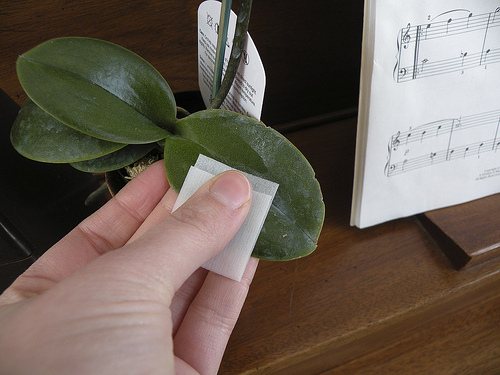

When a white bloom appears on an orchid, it is necessary to initially examine not only the diseased plant, but also those adjacent to it. All flowers on which suspicious signs were found must be quarantined, rearranged in a secluded place.
In the case of powdery mildew development, it is necessary to initially limit watering, allow the substrate to dry out, and also adjust the temperature of the content.
Reasons for the appearance
The main factor contributing to the appearance of this pest is considered unfavorable conditions of detention orchids.
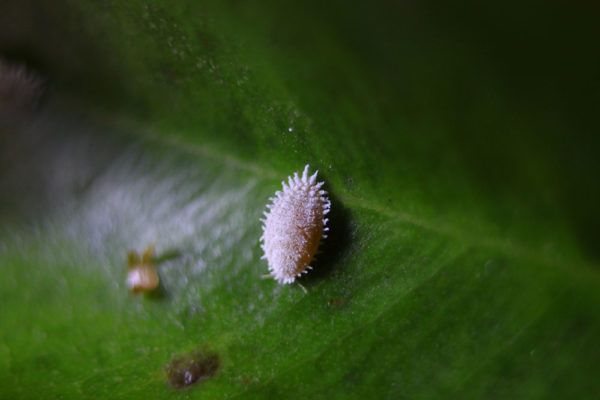

Under unfavorable conditions, a mealybug appears on the orchid.
To the reasons that contribute to the weakening of the plant, relate:
Unfavorable conditions of detention
The optimal time for the development of pests on the orchid is winter, when it is difficult for the plant to create optimal conditions. In this period celebrated:
- Lack of lighting, which can be compensated for by lengthening daylight hours up to 12 hours using a phytolamp;
- Dry air - in the presence of central heating, the humidity in the room is significantly lower than normal
- Improper watering leading to stagnation of water in the substrate.
In such conditions, the orchid is easy exposed to various diseases and the invasion of pests. This can cause problems with leaves and roots.
Putrefactive processes due to waterlogging of the substrate
Too frequent or heavy watering of the orchid often leads to waterlogging and rotting of the substrate.It is fraught numerous problems:
- Decay of roots;
- The appearance of pests or microbial diseases;
- The death of the orchid.
Mealybugs feel comfortable in dry, warm climates, therefore they are afraid of moisture.


When the soil is waterlogged, the roots of the orchid begin to rot.
As practice shows, the orchid, the leaves of which are often wiped or sprayed, is less likely to be affected by the worm.
Infected soil
Often the cause of the appearance of a mealybug on an orchid is contaminated soil when transplanting a plant. To avoid this, you need to purchase a ready-made substrate only in trusted stores. When self-preparing the substrate, the bark is dried in the oven at a temperature of 60 ℃ for 15 minutes.
Dead plant parts not harvested in time
To prevent the spread of the pest, dried leaves and other parts of the plant cut off in a timely manner.
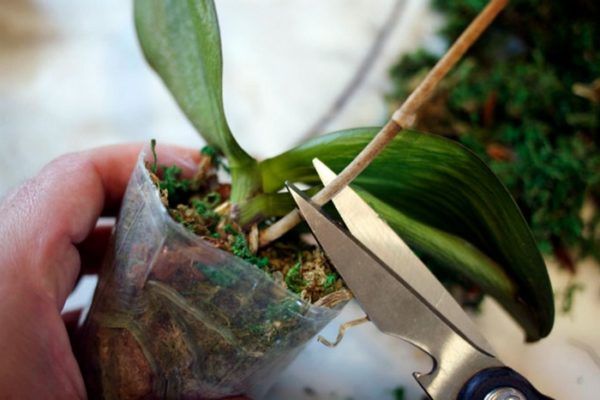

Try to cut off damaged parts of the orchid in time.
Otherwise, they can become a fertile environment for the development of harmful insects and microorganisms.
Non-compliance with the temperature regime
Orchids love warm humid conditions growth:
- The optimum daytime temperature in summer should be 18 to 30 ℃, in winter: + 20-23 ℃;
- Air humidity - not less than 50%.
Uncomfortable temperature impairs growth and development plants.
Other reasons
Often a sticky coating appears due to natural transpiration - the movement of water in the plant. This is a flower nectar that can be washed off with warm water.
Other than that, sticky drops may occur due to:
- Overflow of a plant;
- Excessive top dressing;
- Aphid or scabbard infestation.
The composition of the sticky drops
If the condition is caused by over-watering, the liquid will concentrate in the soil as well as in various parts of the plant. There is so much of it that it cannot be kept inside. As a result, excess moisture is released through the leaves. A large amount of dew is formed, which a person can take for education from pests. The stickiness from the liquid is minimal as the sugar-to-water ratio is lower.
Orchid peduncle: causes of diseases and methods of dealing with them
The plant can secrete liquid on its own. It is necessary to attract insects for pollination or to kill parasites. Then the drops contain sugar particles that attract insects.
Fluid can also form due to the spread of parasites. They attach themselves to the leaves of the orchid, starting to suck the juice out of it. Then they fly over to another part of the plant. In the place where the puncture was made, the juice residue is released. It also contains a lot of sugar, making it sticky to the touch.
For your information! If the plant is exposed to bright sunlight, it begins to secrete liquid in order to protect itself. There is a deficiency inside the leaves, stems and trunk. Therefore, the plant dries up, but excessively sticky drops, like resin, form on top. This is due to the fact that there is little water in them, and a lot of sugar.
Control methods
When signs are found mealybug life activity:
- The flower is isolated from other plants;
- Mechanical cleaning - remove all ovaries and flowers, as well as infected leaves, treat hard-to-reach areas with a cotton swab or wash the plant under running warm water;
- Severely affected foliage is removed;
- Orchid create comfortable conditions, raise the content temperature and humidity;
- The windowsill and objects next to the diseased flower are wiped, since pests can also be located on them.
At the final stage the orchid is being processed using folk remedies or insecticides.
Folk remedies
These methods will do in the early stages orchid infestation:
- Soap-alcohol solution - crushed soap (a teaspoon) and two tablespoons of alcohol or 4 tablespoons of vodka are added to one liter of water. With the finished product, wipe the leaves, stems and leaf sinuses, carefully process the inside of the leaf;
- Two cloves of garlic are crushed and diluted in a liter of water. Orchid sprayed the resulting composition and kept under a plastic bag for a day;
- The plant is wiped with an infusion of calendula on alcohol or an aqueous tincture of tobacco.
Flower processing spend every 3-4 days until the complete disappearance of the pest. It is advisable to alternate home remedies to increase the effectiveness of the treatment.
Chemical and biological products
To the number of biological products Fitosporin belongs... Spraying is carried out 2-3 times with an interval of seven days. If the remedy does not help, you will have to turn to chemistry.
The adult worm is covered with a waxy layer, so contact drugs are weak on it.
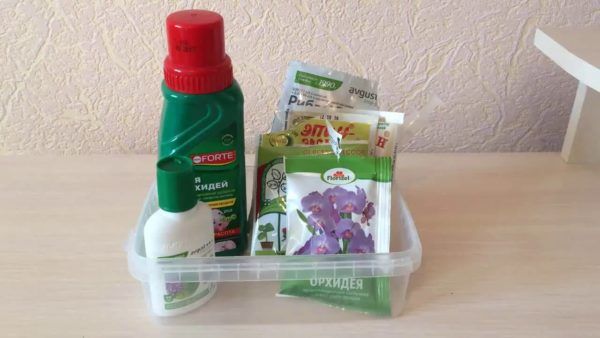

When the state of the orchid is neglected, various preparations should be used.
It is better to destroy them use systemic insecticides:
Apply them in the form of a solution for spraying plants, dilute the product according to the instructions... Since the active ingredient does not affect insect eggs, re-processing is carried out 3-4 times with an interval of 10-14 days.
Features of the use of chemistry
When working with insecticides, strict compliance with safety rules:
- Work with chemicals is carried out in gloves and a respirator;
- After the end of the work, the tools are washed, stored in a special place;
- In case of contact with the skin, the insecticide is washed off with water and detergents. If the product gets into the eyes, rinse with running water;
- When carrying out work, it is prohibited to eat and drink.
Subject to the instructions of the drug, he does not have a harmful effect on the orchid.
Mealybug orchid diseases
White bloom (mealybug) - the reasons for the appearance and possible options for getting rid
As it has been said more than once, the beauties of orchids have become the favorites of many flower growers, which is due not only to the beauty of this plant, but also to the long period of its flowering. Few beautiful flowers can decorate our home with their flowers for more than six months, as the orchid often does.
Nevertheless, we often have to deal with various problems, diseases and ailments that affect this flower. In this article, we will tell you more about how to deal with the appearance of white bloom on an exotic beauty. By the way, you can also read our article on the signs of orchid diseases.
In the event that you notice a strange whitish bloom on the leaves of your orchid, you should not be afraid, it is worth taking action, because this means that your plant has problems that you can cope with. We'll tell you how.
The reasons for the appearance of such a plaque can most often be two:
- the presence of a parasite on orchids called mealybug. It hides on a plant in the form of motionless tubercles. It is not so difficult to find it, since it practically does not move, which also makes it easier to fight with it, but even so, it can cause significant damage to your orchid before you notice it and start fighting it;
- high air humidity, which, in the end, leads to a disease such as powdery mildew. In this case, the plaque is more reminiscent of flour or some kind of white powdery substance. If you do not act immediately in this case, you are putting your plant at risk of death.


WAYS to get rid of white bloom on orchids:
In the event that your plant has suffered from the influence of a mealybug, you need to take the following measures:
- the first step you must take is isolating the diseased plant from others;
- as regrettable as it sounds, you will have to remove the buds and existing flowers;
- we clean the leaves of the plant with an ordinary cotton swab, treating all hard-to-reach places so that no harmful plaque or insects remain there and cause you new problems;
- disinfect and carefully examine the windowsill and everything around the place where your orchid was located, since these harmful insects can live both on the plant itself and on surrounding objects;
- the final stage is a thorough treatment of the orchid with insecticides, which are contained in preparations such as dimethoate pasration, malathion or diazinon. Correct processing should take place in the form of spraying 3-4 times at intervals of 10 days.


